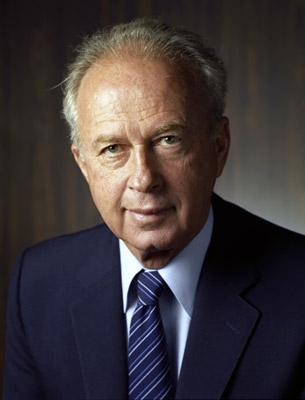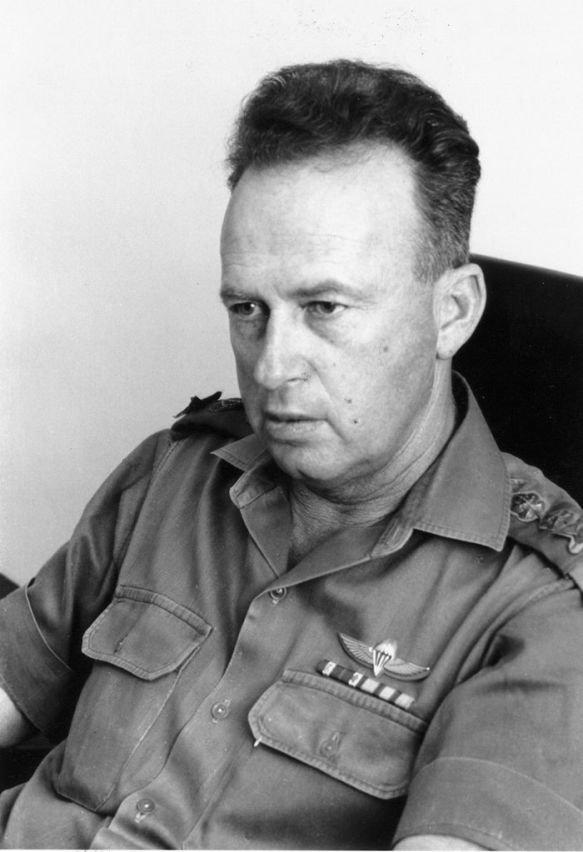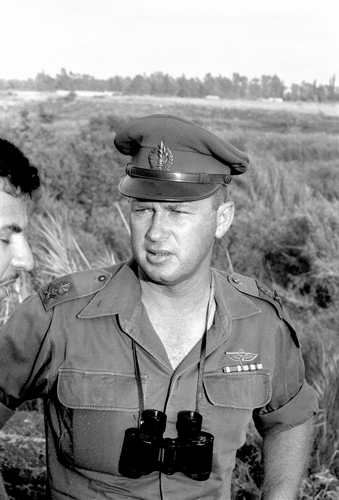<Back to Index>
- Lieutenant General of the IDF and 5th Prime Minister if Israel Yitzhak Rabin, 1922
PAGE SPONSOR



Yitzhak Rabin (Hebrew: יִצְחָק רַבִּין, Arabic: اسحاق رابين; 1 March 1922 - 4 November 1995) was an Israeli politician, statesman and general. He was the fifth Prime Minister of Israel, serving two terms in office, 1974-77 and 1992 until his assassination in 1995.
In 1994, Rabin won the Nobel Peace Prize together with Shimon Peres and Yasser Arafat. He was assassinated by right wing Israeli radical Yigal Amir, who was opposed to Rabin's signing of the Oslo Accords. Rabin was the first native born prime minister of Israel, the only prime minister to be assassinated and the second to die in office after Levi Eshkol.
Rabin was born in Jerusalem on 1 March 1922, British Mandate of Palestine, to Nehemiah and Rosa (née Cohen), two immigrants of the Third Aliyah, the third wave of Jewish immigration to Palestine from Europe. Nehemiah Rubitzov was born in the Ukrainian village Sydorovychi near Ivankiv in 1886. His father died when he was a boy, and he worked to support his family beginning at an early age. At the age of 18, he emigrated to the United States, where he joined the Poale Zion party and changed his surname to Rabin. In 1917, Nehemiah went to the British Mandate of Palestine with a group of volunteers from the Jewish Legion.
Yitzhak's mother, Rosa Cohen, was born in 1890 in Mohilev in Belarus. Her father, a rabbi, opposed the Zionist movement and sent Rosa to a Christian high school for girls in Homel, which gave her a broad general education. Early on, Rosa took an interest in political and social causes. In 1919, she traveled to the region on the steamship Ruslan. After working on a kibbutz on the shores of the Sea of Galilee, she moved to Jerusalem.
Rabin grew up in Tel Aviv, where the family relocated when he was one year old. In 1940, he graduated with distinction from the Kadoori Agricultural High School and hoped to be an irrigation engineer. However, apart from several courses in military strategy in the United Kingdom later on, he never pursued a degree.
Rabin married Leah Rabin (born Schlossberg) during the 1948 Arab - Israeli War. Leah Rabin was working at the time as a reporter for a Palmach newspaper. They had two children, Dalia and Yuval. Rabin was non - religious; according to American diplomat Dennis Ross, Rabin was the most secular Jew he had met in Israel.
In 1941, during his practical training at kibbutz Ramat Yohanan, Rabin joined the Palmach section of the Haganah, under the influence of Yigal Allon. The first operation he participated in was assisting the allied invasion of Lebanon, then held by Vichy French forces (the same operation in which Moshe Dayan lost his eye) in June - July 1941.
After the end of the war the relationship between the Palmach and the British authorities became strained, especially with respect to the treatment of Jewish immigration. In October 1945 Rabin was in charge of planning and later executing an operation for the liberation of interned immigrants from the Atlit detainee camp for Jewish illegal immigrants. In the Black Shabbat, a massive British operation against the leaders of the Jewish Establishment in British Mandate Palestine, Rabin was arrested and detained for five months. After his release he became the commander of the second Palmach battalion and rose to the position of Chief Operations Officer of the Palmach in October 1947.
During the 1948 Arab - Israeli War Rabin directed Israeli operations in Jerusalem and fought the Egyptian army in the Negev. During the beginning of the war he was the commander of the Harel Brigade, which fought on the road to Jerusalem from the coastal plain, including the Israeli "Burma Road", as well as many battles in Jerusalem, such as securing the southern side of the city by recapturing kibbutz Ramat Rachel.
During the First truce he participated in the altercation between the IDF and the Irgun on the beach of Tel Aviv as part of the Altalena Affair.
In the following period he was the deputy commander of
Operation Danny, the largest scale operation to that
point, which involved four IDF brigades. The cities of Ramle and Lydda were
captured, as well as the major airport in Lydda, as part
of the operation. Following the capture of the two towns there was an exodus of their Arab
population. Rabin signed the expulsion order,
which included the following,
"... 1. The inhabitants of Lydda must be expelled quickly
without attention to age. ... 2. Implement immediately."
Later, Rabin was Chief of Operations for the Southern
Front and participated in the major battles ending the
fighting there, including Operation Yoav and Operation
Horev.
In the beginning of 1949 he was a member of the Israeli delegation to the armistice talks with Egypt that were held on the island of Rhodes. The result of the negotiations were the 1949 Armistice Agreements, which ended the official hostilities of the 1948 Arab - Israeli War. Following the demobilization at the end of the war he was the most senior (former) member of the Palmach that remained in the IDF.
In 1964 he was appointed Chief of Staff of the Israel Defence Forces (IDF) by Levi Eshkol, who replaced David Ben - Gurion and, like him, served as Prime Minister and Minister of Defense. Since Eshkol did not have much military experience, Rabin had a relatively free hand.
Under his command, the IDF achieved victory over Egypt, Syria and Jordan in the Six Day War in 1967. After the Old City of Jerusalem was captured by the IDF, Rabin was among the first to visit the Old City, and delivered a famous speech on Mount Scopus, at the Hebrew University. In the days leading up to the war, it was reported that Rabin suffered a nervous breakdown and was unable to function. After this short hiatus, he resumed full command over the IDF.
Following his retirement from the IDF he became ambassador to the United States beginning in 1968, serving for five years. In this period the US became the major weapon supplier of Israel and in particular he managed to get the embargo on the F-4 Phantom fighter jets lifted. During the 1973 Yom Kippur War he served in no official capacity and in the elections held at the end of 1973 he was elected to the Knesset as a member of the Alignment. He was appointed Israeli Minister of Labor in March 1974 in Golda Meir's short lived government.
Following Golda Meir's resignation in April 1974, Rabin was elected party leader, after he defeated Shimon Peres. The rivalry between these two labor leaders remained fierce and they competed several times in the next two decades for the leadership role. Rabin succeeded Golda Meir as Prime Minister of Israel on 3 June 1974. This was a coalition government, including Ratz, the Independent Liberals, Progress and Development and the Arab List for Bedouins and Villagers. This arrangement, with a bare parliamentary majority, held for a few months and was one of the few periods in Israel's history where the religious parties were not part of the coalition. The National Religious Party joined the coalition on 30 October 1974 and Ratz left on 6 November.
In foreign policy, the major development at the beginning of Rabin's term was the Sinai Interim Agreement between Israel and Egypt, signed on 1 September 1975. Both countries declared that the conflict between them and in the Middle East shall not be resolved by military force but by peaceful means. This agreement followed Henry Kissinger's shuttle diplomacy and a threatened 'reassessment' of the United States' regional policy and its relations with Israel. Rabin notes it was, "an innocent - sounding term that heralded one of the worst periods in American - Israeli relations". The agreement was an important step towards the Camp David Accords of 1978 and the peace treaty with Egypt signed in 1979.
Operation Entebbe was perhaps the most dramatic event during Rabin's first term of office. On his orders, the IDF performed a long range undercover raid to rescue passengers of an airliner hijacked by militants belonging to the Popular Front for the Liberation of Palestine's Wadie Haddad faction and the German Revolutionary Cells (RZ), and had been brought to Idi Amin's Uganda. The operation was generally considered a tremendous success, and its spectacular character has made it the subject of much continued comment and study.
Towards the end of 1976 his coalition government with the religious parties suffered a crisis: A motion of no confidence had been brought by Agudat Israel over a breach of the Sabbath on an Israeli Air Force base when four F-15 jets were delivered from the US and the National Religious Party had abstained. Rabin dissolved his government and decided on new elections, which were to be held in May 1977.
Following the March 1977 meeting between Rabin and U.S. President Jimmy Carter, Rabin publicly announced that the U.S. supported the Israeli idea of defensible borders; Carter then issued a clarification. A "fallout" in U.S. / Israeli relations ensued. It is thought that the fallout contributed to the Israeli Labor Party's defeat in the May 1977 elections. At the same time, it was revealed that his wife, Leah, continued to hold a US dollar account from the days that Rabin was ambassador to the United States. According to Israeli currency regulations at the time, it was illegal for citizens to maintain foreign bank accounts without prior authorization. In the wake of this disclosure, Rabin handed in his resignation from the party leadership and candidacy for prime minister, an act that earned him praise as a man of integrity.
Following his resignation and Labor Party defeat at the elections, Likud's Menachem Begin was elected in 1977. Until 1984 Rabin was a member of Knesset and sat on the Foreign Affairs and Defense Committee. From 1984 to 1990, he served as Minister of Defense in several national unity governments led by prime ministers Yitzhak Shamir and Shimon Peres.
When Rabin came to office, Israeli troops were still deep in Lebanon. Rabin ordered their withdrawal to a "Security Zone" on the Lebanese side of the border. The South Lebanon Army was active in this zone, along with the Israeli Defense Forces.
When the first Intifada broke out, Rabin adopted harsh measures to stop the demonstrations, even authorizing the use of "Force, might and beatings," on the demonstrators. Rabin the "bone breaker" was used as an International image. The combination of the failure of the "Iron Fist" policy, Israel's deteriorating international image and Jordan cutting legal and administrative ties to the West Bank with the U.S.'s recognition of the PLO as the representative of the Palestinian people forced Rabin to seek an end to the violence through negotiation and dialogue with the PLO.
In 1990 to 1992, Rabin again served as a Knesset member and sat on the Foreign Affairs and Defense Committee.
In 1992 Rabin was elected as chairman of the Labor Party, winning against Shimon Peres. In the elections that year his party, strongly focusing on the popularity of its leader, managed to win a clear victory over the Likud of incumbent Prime Minister Yitzhak Shamir. However the left wing bloc in the Knesset only won an overall narrow majority, facilitated by the disqualification of small nationalist parties that did not manage to pass the electoral threshold. Rabin formed the first Labor led government in fifteen years, supported by a coalition with Meretz, a left wing party, and Shas, a Mizrahi ultra - orthodox religious party.
Rabin played a leading role in the signing of the Oslo Accords, which created the Palestinian National Authority and granted it partial control over parts of the Gaza Strip and West Bank. Prior to the signing of the accords, Rabin received a letter from PLO Chairman Yasser Arafat renouncing violence and officially recognizing Israel, and on the same day, 9 September 1993, Rabin sent Arafat a letter officially recognizing the PLO.
After the announcement of the Oslo Accords there were many protest demonstrations in Israel objecting to the Accords. As these protests dragged on, Rabin insisted that as long as he had a majority in the Knesset he would ignore the protests and the protesters. In this context he said, "they (the protesters) can spin around and around like propellers" but he would continue on the path of the Oslo Accords. Rabin's parliamentary majority rested on non - coalition member Arab support. Rabin also denied the right of American Jews to object to his plan for peace, calling any dissent "chutzpah".
After the historical handshake with Yasser Arafat, Rabin said, on behalf of the Israeli people: "We who have fought against you, the Palestinians, we say to you today, in a loud and a clear voice, enough of blood and tears ... enough!" During this term of office, Rabin also oversaw the signing of the Israel-Jordan Treaty of Peace in 1994.
For his role in the creation of the Oslo Accords, Rabin was awarded the 1994 Nobel Peace Prize, along with Yasser Arafat and Shimon Peres. The Accords greatly divided Israeli society, with some seeing Rabin as a hero for advancing the cause of peace and some seeing him as a traitor for giving away land they viewed as rightfully belonging to Israel. Many Israelis on the right wing often blame him for Jewish deaths in terror attacks, attributing them to the Oslo agreements.
Rabin was also awarded the 1994 Ronald Reagan Freedom Award by the former president's wife, former First Lady Nancy Reagan. The award is only given to "those who have made monumental and lasting contributions to the cause of freedom worldwide," and who "embody President Reagan's lifelong belief that one man or woman truly can make a difference.".
On the evening of 4 November 1995 (12th of Heshvan on the Hebrew Calendar), Rabin was assassinated by Yigal Amir, a radical right wing Orthodox Jew who opposed the signing of the Oslo Accords. Rabin had been attending a mass rally at the Kings of Israel Square (now Rabin Square) in Tel Aviv, held in support of the Oslo Accords. When the rally ended, Rabin walked down the city hall steps towards the open door of his car, at which point Amir fired three shots at Rabin with a semi - automatic pistol. Two shots hit Rabin, and the third lightly injured Yoram Rubin, one of Rabin's bodyguards. Rabin was rushed to nearby Ichilov Hospital, where he died on the operating table of blood loss and a punctured lung within 40 minutes. Amir was immediately seized by Rabin's bodyguards. He was later tried, found guilty, and sentenced to life imprisonment. After an emergency cabinet meeting, Israel's foreign minister, Shimon Peres, was appointed as acting Israeli prime minister.
Rabin's assassination came as a great shock to the Israeli public and much of the rest of the world. Hundreds of thousands of Israelis thronged the square where Rabin was assassinated to mourn his death. Young people, in particular, turned out in large numbers, lighting memorial candles and singing peace songs. Rabin's funeral was attended by many world leaders, among them U.S. president Bill Clinton, Australian Prime Minister Paul Keating, Egyptian president Hosni Mubarak and King Hussein of Jordan. Clinton delivered a eulogy whose final words were in Hebrew – "Shalom, Haver" (Hebrew: שלום חבר, lit. Goodbye, Friend).
The square where he was assassinated, Kikar Malkhei Yisrael (Kings of Israel Square), was renamed Rabin Square in his honor. Many other streets and public institutions in Israel have also subsequently been named after him. After his assassination, Rabin was hailed as a national symbol and came to embody the Israeli peace camp ethos, despite his military career and hawkish views earlier in life. He is buried on Mount Herzl. In November 2000, his wife Leah died and was buried alongside him.
After the murder, it was revealed that Avishai Raviv, a well known right wing extremist at the time, was in fact a Shin Bet agent - informer codenamed Champagne. Raviv was later acquitted in court of charges that he failed to prevent the assassination. The court ruled there was no evidence that Raviv knew assassin Yigal Amir was plotting to kill Rabin.
There are a number of conspiracy theories related to the assassination of Rabin. However, the sources of these conspiracies are predominately right wing extreme groups who attempt to spread doubt in the guilt of the murderer, Yigal Amir.
After Rabin's assassination, his daughter Dalia Rabin - Pelossof entered into politics and was elected to the Knesset in 1999 as part of the Center Party. In 2001, she served as Israel's Deputy Minister of Defense.
The Knesset has set the 12th of Heshvan, the murder date according to the Hebrew calendar, as the official memorial day of Rabin. An unofficial but widely followed memorial date is 4 November, the date according to the Gregorian calendar.
In 1995 the Israeli Postal Authority issued a commemorative Rabin stamp.
The Yitzhak Rabin Center was founded in 1997 by an act of the Knesset, to create "[a] Memorial Center for Perpetuating the Memory of Yitzhak Rabin." It carries out extensive commemorative and educational activities emphasizing the ways and means of democracy and peace.
Mechinat Rabin, an Israeli pre-army preparatory program for training recent high school graduates in leadership prior to their IDF service, was established in 1998.
Many cities and towns in Israel have named streets, neighborhoods, schools, bridges and parks after Rabin. Also two government office complexes and two synagogues are named after Yitzhak Rabin. Outside Israel, there are streets named after him in Bonn, Berlin and New York and parks in Montreal, Paris, Rome and Lima. The community Jewish high school in Ottawa is also named after him.
The Cambridge University Israel Society host its annual academic lecture in honor of Yizhak Rabin.
In 2005, he was voted the greatest Israeli of all time, in a poll by the Israeli news website Ynet to determine whom the general public considered the 200 Greatest Israelis.
